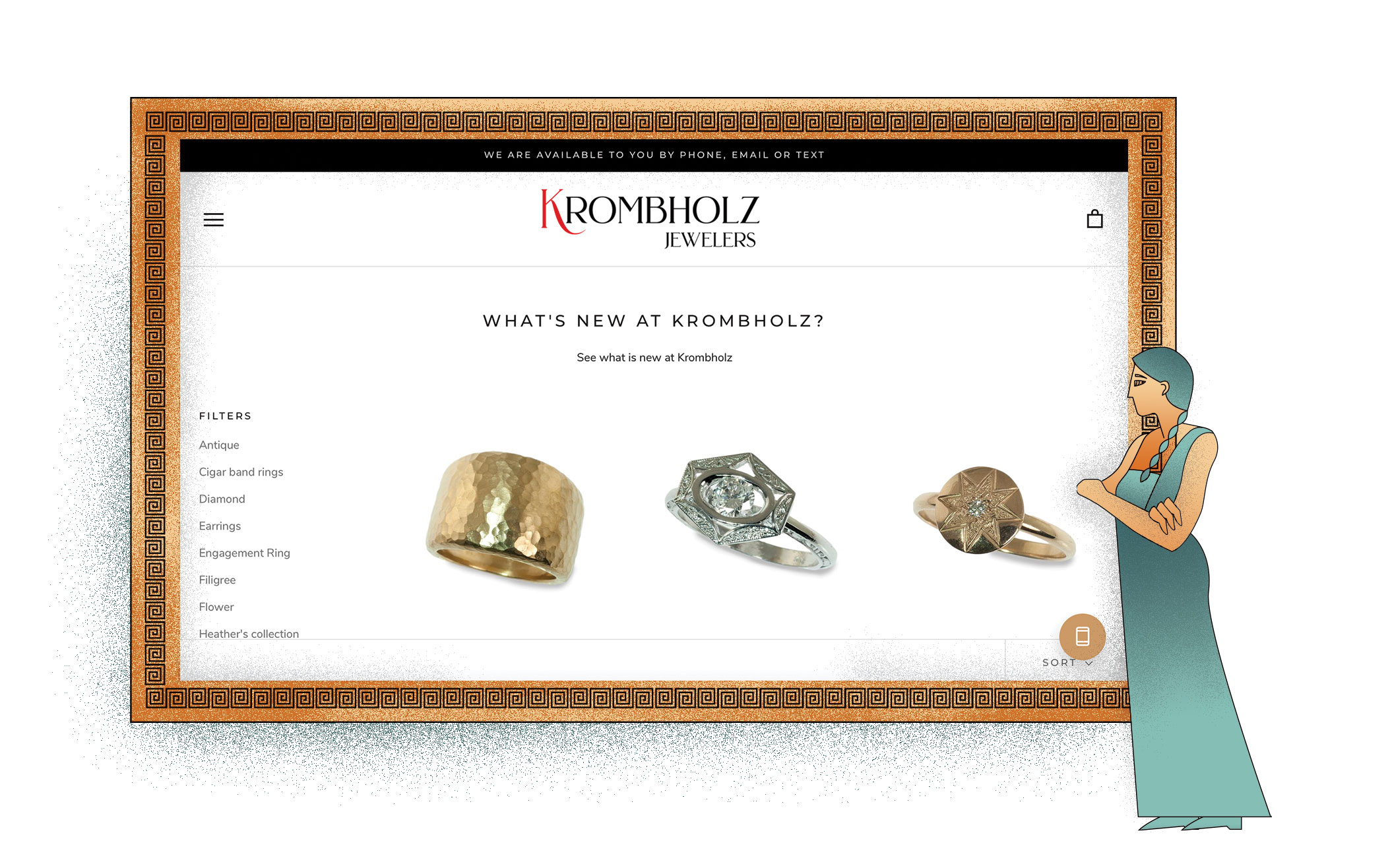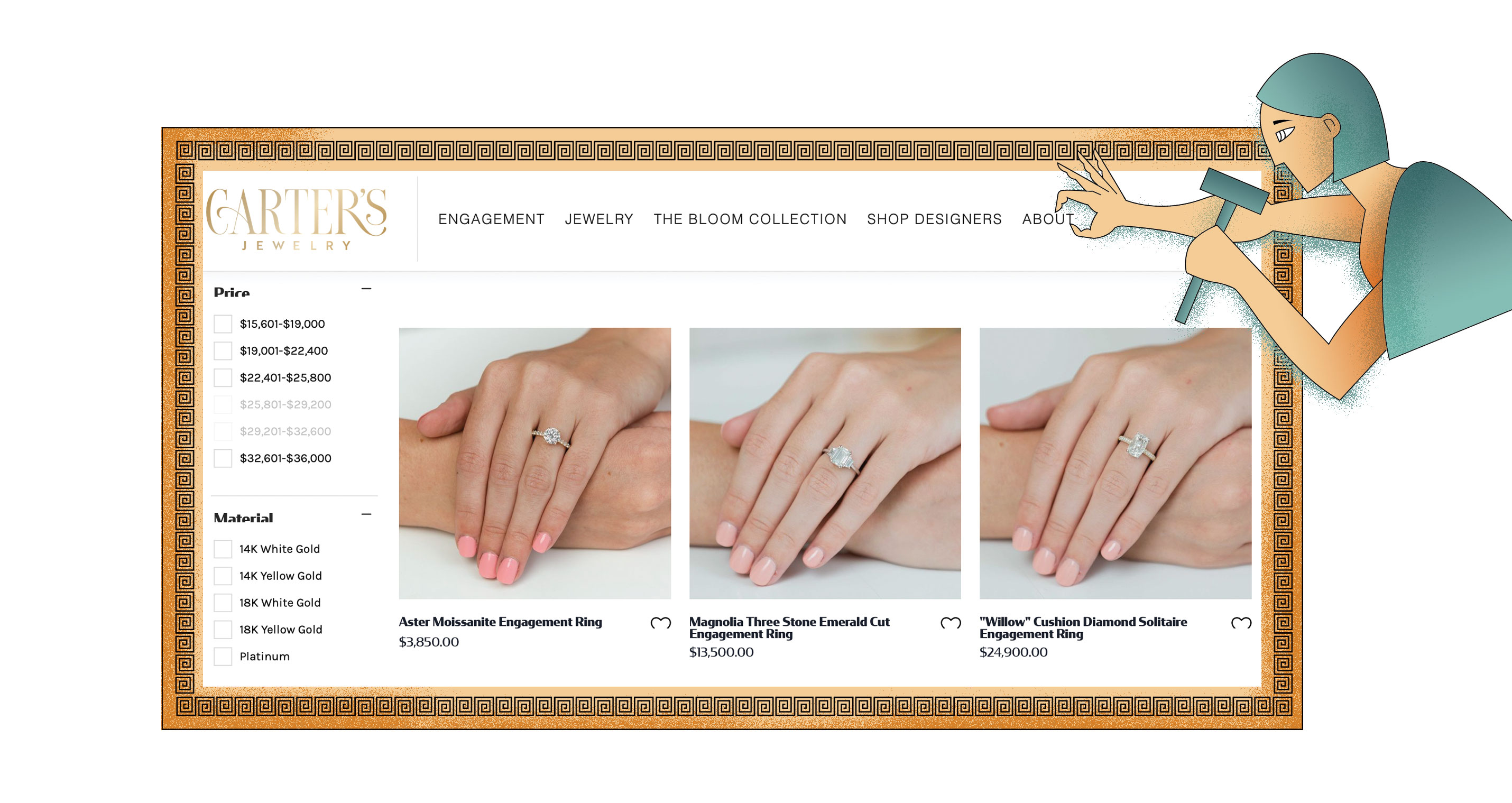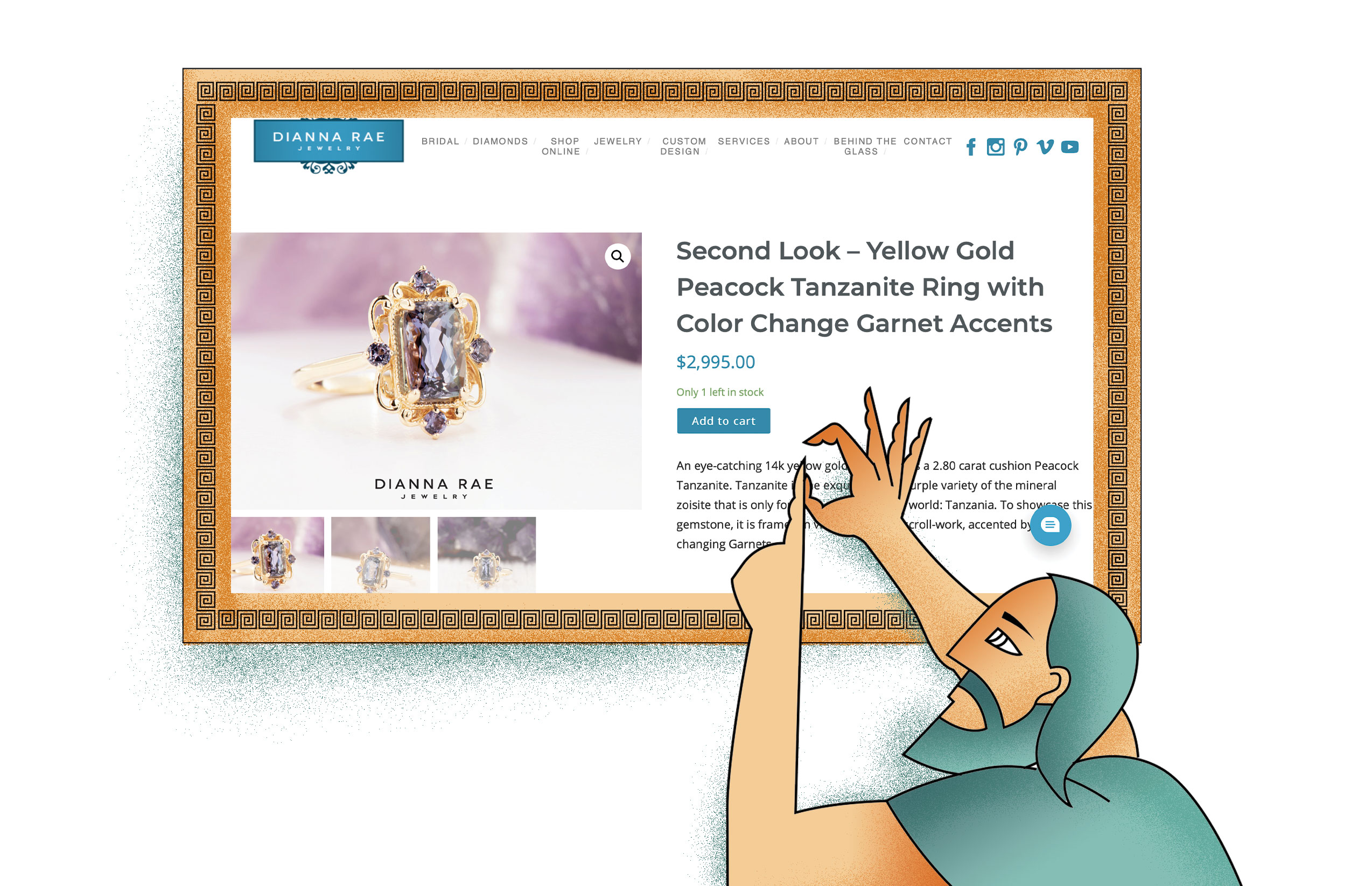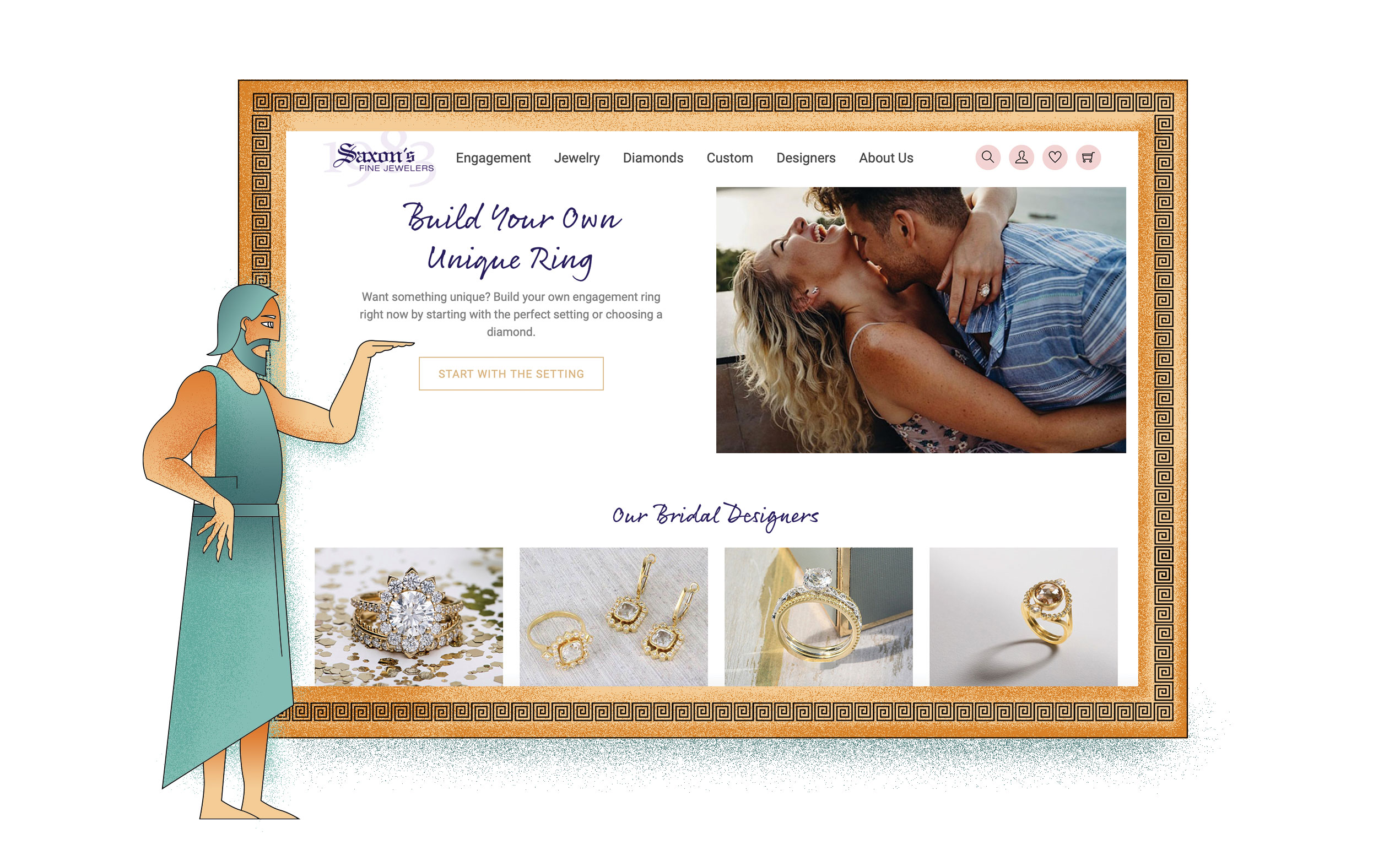IMAGINE IF YOU were to tell a store designer, “Let’s just build a new store that looks exactly like my competitor’s down the street.”
While it seems unimaginable in that context, that’s essentially what often happens when it comes to building a website, says Andrea Hill, CEO of Hill Management Co. There’s no such thing as a perfect website for every retail jeweler, and you should consider yours a point of differentiation.
To begin with, be very clear about your goals, says Ross Cockerham, CEO and co-founder of Punchmark. “Do you want to become a $2 million store? Or make $100,000 in sales online in 2021? Or pick up X amounts of new leads this year? Think about what those goals are and create questions for developers based on those goals.”
For Lee Krombholz, owner of Krombholz Jewelers in Cincinnati, last year’s development of a new website was largely a matter of convenience, both for his customer base and for himself. He wanted to be open fewer hours in his physical store, but he also wanted his customers to be able to shop 24/7. His customers had also told him they experienced difficulty completing purchases with his old platform; he switched to a Shopify-based platform to eliminate those issues.
To work toward those goals, he collaborated with a freelance art director and engaged freelance Shopify web developers who bid on certain pieces of the design puzzle as his needs became clear.
Photography duties are split between Krombholz and his daughter Izzi, who updates inventory as well. “I’m not looking to find people all over the world, and I don’t look at it as a place where somebody stumbles into it and finds something,” Krombholz says. “It’s an extension of our store for people who want to shop at night or just can’t get in during our fairly short business hours.” Development costs have been modest, and Shopify subscription fees run $350 a month. “We keep pushing to make sure it’s personal, that it looks like us, it feels like us. It’s an extension of what our store is.”
Your website should look like you, says Andre Savoie of High Level Thinkers, a digital marketing specialist. “Independent jewelers have a unique personality, a unique culture and should play to their strengths. That’s what bonds customers to them.” Think of your website as the very first conversation you’re having with customers, a conversation that should continue when they visit the store.
Savoie says the goal of websites is to match information, images and product offerings as closely as possible to the experience of walking into the store, rather than trying to emulate the e-commerce experience of the likes of James Allen and Blue Nile. This can require a shift in thinking for independent retailers, from considering online sellers the impersonal enemy to personalizing the online shopping experience for themselves and their clients.

The Krombholz Jewelers website focuses on original and antique creations that can’t be price-shopped.
Letting viewers get to know you is one path to authenticity, because clients want to work with, or buy from, someone they love, says Jennifer Shaheen, president of Technology Therapy Group. “Having a video on your website showing your team members does make a difference in understanding and connecting with your business,” Shaheen says. “Having team members do their own product reviews would be fabulous.”
Another reason authenticity is important is that today’s customer doesn’t want to be surprised when venturing into your brick-and-mortar space, says Mike Hauben, president and developer at Jewelry Ecomm. “They want to already have an idea of what they’re walking into,” he says.
Websites have evolved from a static extension of the business card to what should be a dynamic representation of a second storefront, says Alex Fetanat of Gemfind. They must be reflective of the brand as well as up to date and functional. That was driven home by the events of 2020.
Advertisement
Lake Giles, director of operations and sales at Thinkspace, says his clients, equipped with robust e-commerce websites, increased their online sales fourfold last year. U.S. independents that didn’t perform well failed to recognize the importance of their websites pre-COVID and didn’t update their hours or indicate whether they had curbside pickup once the pandemic forced closings. Posting such information on Facebook, although it may seem easy, isn’t effective, especially since only one in 100 followers will see it (unless you have a Facebook ad program).
Personalization extends to inventory curation. Showing jewelry that can be shopped anywhere leads to a generic look. “Pulling in other inventories is so 2005, and not the way you want people to shop now,” says Shane O’Neill, vice-president of Fruchtman Marketing. “You can bring in other stuff to supplement your inventory, but it shouldn’t be your core offerings.”
Some experts advise showing the most interesting pieces you’ve got, rather than highlighting jewelry from lines featured on a dozen other websites. Encourage shoppers to get in touch to talk about which pieces work for them, Savoie says. “The people who choose the local jewelers are the people who want help and want to work with someone local.”
Krombholz, for example, shows about 20 percent of his store’s inventory online and concentrates on antiques and original creations, rather than paperclip chains or diamond stud earrings. “I want it to be things people aren’t seeing other places,” he says. “That is our strength and the backbone of our busines moving forward.”
Chae Carter of Carter’s Jewelry of Petal in Petal, MS, was initially excited to try to upload her entire inventory when her Punchmark-designed website went live 18 months ago, but last spring, she began curating her offerings for a better presentation of each piece. Now pieces selected for the website are shown with a lifestyle or hand-model photo in response to customers who clamored to see what a ring or an earring looked like on someone.

Lifestyle or hand-model photos can help shoppers envision what a piece looks like when worn.
Dedicating in-house time to adding content, improving their social media game, and integrating with Podium for chat and reviews (600 and counting on Google) helped drive $75,000 worth of direct online business in 2020. Even more significantly, nearly everyone who visited the store referred to something specific they’d seen on the website and usually wanted to buy it on the spot. In all, website-driven sales are estimated to be $500,000. The buying team works with brands and designers that provide lifestyle photos, but her in-house team also uses a Gem Lightbox and outdoor natural lighting to photograph jewelry and employee-models wearing jewelry.
While jewelry retailers are selling more than they used to online, much of the increase can be traced to ordering online and picking up in store, and to customers adding items to their cart and scheduling a consultation. “This gives local jewelers the edge that national companies can’t compete with,” Savoie says. “Develop a relationship. They become a customer for life and that’s what fuels the business.”
Websites should seamlessly reflect the retailer’s marketing message. “If you don’t know who you are and what makes you different and why you matter, your customers aren’t going to know, either,” Hill says. “A website is a living, breathing piece of marketing, and every single piece of it should be expressing your reason for existence.”
Sales manager Rebecca Larson deploys social media and email marketing to drive traffic to the website she manages for Barry Peterson Jewelers in Ketchum, ID. The website, introduced last year, has streamlined sales by facilitating an omnichannel experience. “If they’re in the store and they need to think about an item, the customer has an online reference point to show friends, and since they have already seen the item in person, there is consumer confidence built to purchase from us online.
“This ultimately creates more conversions from browsers in store, but it’s also a way for these customers to organically promote us when they share product links to friends.” She’s implementing QR codes not only in print advertising but also in displays in street-facing windows. “Those walking by can scan the code and discover more about a product on our website, which has also driven sales.”
At least a quarter of Barry Peterson’s sales revenues are related to the website. Costs include Larson’s time and a basic $30 monthly subscription to Shopify. Updating the website helped the business through 2020 when COVID concerns limited ski vacations in the tourist town and restricted walk-in traffic.
Often the purchase isn’t finalized online. Instead, the website acts like a funnel. “We close the deal over the phone, or they will say, ‘I saw this and I want to try it on,’” Larson says. “Or it works in reverse. They come in and see something, and if they are in town for only a week or two, they might order it later.”
Advertisement
Every website should be ever evolving, a work in progress.
The team at Croghan’s Jewel Box in Charleston, SC, overhauled their website in early 2019 and is in the midst of an update just two years later. The goal is to offer video of every product on the site and to enable administrators to view products customers have in wish lists. Efforts are coordinated between a full-time, in-house content manager, a local website developer on contract and a digital media agency.
Owner Rhett Outten says Southern hospitality ensures visitors return to the site often, and no matter where they live, they say they feel as if they’ve visited Charleston. Outten credits the store’s longstanding relationship with their local web developer, originally hired as a graphic artist, for conveying the brand’s essence.
“If you can find someone local in your community who understands who you are and what your strengths are, that’s important,” Outten says. “Gosh, it’s helpful just to be able to go out and have coffee with them, rather than email back and forth!”
At least 12 percent of revenue comes directly from online purchases, while an untold number of Croghan shoppers begin their journey on the website. Jewelry collections emphasize local themes.

Dianna Rae Jewelry’s website uses WordPress and WooCommerce for faster load times and e-commerce.
ASSESS WHAT YOU HAVE AND WHAT YOU NEED
O’Neill thinks of the website as a salesperson. Take an assessment of your website on a yearly basis, just as you’d evaluate an employee. The customer journey should flow from start to finish.
Michael O’Connor, who spearheaded the recent redesign of the Plumb Club’s website, called in an expert to analyze the site after he realized he was having difficulty finding what he was looking for in the course of his work. That’s an experiment that Shaheen recommends. “Go to your website with the intention of finding something specific in under 30 seconds. If you can’t, odds are your customers can’t either.”
Another test is loading speed. If it takes 5 to 8 seconds, that’s not fast enough, Shaheen says. Compress photo sizes to speed things up. Make sure what you’ve posted is not insanely big — 800 to 1,000 pixels at most — and then use an app like JPEGmini, suggests O’Neill, to reduce file sizes up to 50 percent or more.
Most marketing agencies will offer to review your website for free, O’Neill says. Describe your objectives and ask the reviewer, “Will this platform get me there?”
For Dianna Rae High of Dianna Rae Jewelry in Lafayette, LA, the answer was clearly no, when three years ago, she hired Technology Therapy to redo her website. High had been stymied by her Squarespace platform, which couldn’t accommodate photo galleries, video links and high-resolution images of custom jewelry. “We asked Jennifer to create a new site for us using WordPress and WooCommerce for faster load times and online sales,” she says. “People can now browse our styles and learn about our custom process before they come into the store. They often come in with screen shots of jewelry they found on our website, making the sales process shorter and easier.”
Whether or not you’ve got to start over depends on several factors, says Matthew Perosi, chief thinker at Jeweler Websites Inc. An outdated website probably is on an older platform, in which case it makes sense to start over with a new installation of that platform, or to migrate to something that will make it easy to manage e-commerce while planning out other ways to implement digital features to complement your physical store.
If you’re paying a monthly subscription to a company that integrates with a diamond feed or your POS and you’re happy with that, but frustrated with everything else about the website, Hill says, you can wrap a WordPress or a Joomla piece around these platforms and let your commerce part hum along uninterrupted. It’s like putting a jacket on it to improve marketing functionality.
E-commerce conveys credibility, whether or not you want to sell anything virtually. “I’m not going to shop somewhere if they don’t have e-commerce these days because it means the business is not keeping up with the times,” Hauben says.
Think about how you’re receiving payment and consider adding a trusted platform like PayPal or PayPal pro or advanced, which upgrades security. “Free shipping is a no-brainer; it’s the cost of doing business, in our opinion,” O’Neill says. As Cockerham puts it, “Imagine buying something for $5,000 and then finding out shipping costs $22. In 2019, 63 percent of cart abandonments were due to unexpected shipping costs. You could lose a $5,000 sale over shipping.”
Emmanuel Raheb of Smart Age Solutions says when shopping online, 66 percent of clients value convenience over everything else. He recommends offering one-click payment with Apple Pay for a frictionless experience. In addition, make sure you’re set up to respond immediately when you receive an inquiry from a customer via chat or text on your website. Failure to do so within 10 minutes could turn a hot lead into a cold one due to customer frustration.

The Saxon’s Fine Jewelry website integrates with both favorite vendors and point-of-sale software The Edge.
WEIGH THE OPTIONS
There are three basic types of websites: custom websites, website builders, and CMS (or content management systems). A custom site, created from scratch by a developer, offers complete creative and functional freedom. The cost range can be prohibitive at $20,000 to $50,000 without photography. The cost of ownership is high, too, since you’ll pay every time something needs to change.
A website builder, such as Shopify, Wix, Weebly, Squarespace, etc., is focused on e-commerce. Its advantages are ease of use, fast startup, low maintenance, low cost of setup and built-in support and hosting. The platform controls security and updates. The site itself can be set up within days, but it may take weeks to add products. Cost of ownership varies, but can be moderate to high with add-ons, plug-ins, and monthly subscription fees or a percentage of total sales.
A CMS is designed to manage content, including e-commerce and SEO. Examples are WordPress, Joomla and Magento. This type allows for design deviations within a structured environment. A CMS site could take three to six weeks to set up. For an assisted WordPress site, expect to pay between $2,000 and $8,000. For Joomla and Magento, $8,000 to $30,000. Cost of ownership is low to moderate. The core software is free, so you’ll pay for support and updates.
Within the jewelry industry, hybrid versions of these general types are common, Hill says. There are WordPress hosting options that function like website builders, custom developers who create their own CMS, and development firms that build something on top of another platform.
Some jewelry-specific web development companies (like Punchmark, Thinkspace and Jeweler Websites) operate with software as a service (SaaS) business models, which mean the company leases the software to customers via a subscription plan. Advantages are that these businesses usually provide packages of full-service or a la carte options and use platforms made for jewelry. This model is designed for a long-term partnership. If the software is proprietary and you part ways with the developer, they own the software, and you will need to migrate the content to another system.
Others (Gemfind and Jewelry Ecomm, for example) use open-source platforms, such as WordPress or Shopify. The client owns the website, and any developer who works on these types of platforms can manage them. They also offer monthly maintenance and support plans.
THE BOTTOM LINE: WHAT SHOULD IT COST?
Fetanat estimates a user-friendly themed website that represents your brand and is built by a developer could cost between $8,000 and $15,000. “Spend $10,000 to $12,000 on something decent and you can always build on it,” he suggests. “The website shouldn’t be static; it should be dynamic.”
Most companies that build websites offer predesigned templates or themes, says Savoie. “Usually, this is a very good option for a smaller company that might cost $2,500 to $5,000. But I also have worked with clients who are very protective of their brand and image and wanted those platforms customized, and they’ve spent $10,000 to $20,000 on a website.”
When weighing options, compare costs of monthly subscriptions, management and maintenance. That can run as low as $50 for a business with a few hundred photos to manage up to $500 or $600 a month for full professional support and integration with a POS system.
Put the cost of a website in perspective. “You’re not selling cheap items,” Fetanat says. “If the lifetime value of a customer is several thousand dollars or potentially tens of thousands of dollars and a website costs you $10,000 or $15,000, you’ve got to calculate how many new customers this needs to generate to make up this investment.”
Alan Perry, owner of Perry’s Emporium in Wilmington, NC, contracted with jewelry-specific website developer Punchmark for a premium site and found it very quickly paid for itself. “Wow,” he says. “The first day we sold $5,000 online. In 30 days, we sold about $16,000. We went all in and paid for the best and got the best.”
OTHER POINTS TO CONSIDER
Talk to developers about long term plans, Giles suggests. Let them know what you need now and ask whether they can add to it later to avoid having to start over when you learn your website is built on something that can’t grow. Quote it out and see how far you are from having the ideal website. Then choose the ideal website or begin with the understanding you can build up to your ideal slowly.
Kati Magana, marketing and social media specialist for Saxon’s Fine Jewelers in Bend, OR, studied options for a year before settling on Punchmark to develop a premium-level website that integrates with favorite vendors as well as with The Edge POS; inventory disappears from view as soon as it is sold. “We’ve been able to confidently say, ‘If it’s on the website, it is in stock.’”
When doing your own research, ask a lot of questions, says Hauben. “There’s no barrier to entry,” he warns. “To become a web developer or digital marketer, all you have to do is change your digital profile.”
If you’re using a builder format, you don’t need to arrange for hosting, but you do need the developer to set up your domain name and server management. If your developer is personally hosting the site, you should know where their servers are located. “They should be on the ‘cloud,’ and not on five servers on a rack in the developer’s basement,” Hill advises.
If your site is hosted by GoDaddy or Network Solutions, the cost scales with the growth of the site, from $12.99 to begin with and up to $15 or $29 as the site grows. The business owner can also set up a GoDaddy account and allow the developer delegate access only, leaving the store owner with primary control.
Retailers should be able to integrate their jewelry POS system (The Edge, ARMS, or Logic Mate, for example) with their websites to avoid double data entry work.
Make a list of all the things you want your website to accomplish, says Hill. “Ask yourself, ‘What do we do that makes us different? Why do we matter to our customers? How many people do we need to attract to the site to get the sales we want?’ Create a list of features and experiences for your web environment to deliver that experience to your customers. Then choose a website system closest to your budget and its capabilities.”
WHAT DOES THE FUTURE LOOK LIKE?
Charles Bonas, director of the Bonas Group in London, a global diamond brokerage and consulting firm, also owns Holition, which specializes in 3D augmented reality websites used primarily for beauty brands. Jewelry brands should get on board, he believes.
“Most luxury brands have two-dimensional websites,” he explains. “If I’m looking for a pair of earrings, I click on the earrings and see maybe five images, maybe a little movie of it if it’s really sophisticated.”
The jewelry industry offers content that’s crying out for exciting formats, Bonas says. “The artisanship, the brand history, the good work that that retailer might do in his or her community, all of these stories are told in a very staid way. And with people’s attention spans being about a minute, that’s not enough.”
Advertisement
An experience can be hyper-realistic, like that of Ralph Lauren’s virtual locations, or it can be magical, like the experience Holition helped create for the beauty brand Jo Malone. Visitors to the site enter rooms with 360-degree views, whimsical drawings and tranquil music. They click on gift boxes to learn about products. And the rooms can reflect what you’d do seasonally in your store. “Let’s say they launch a new collection in a room,” Bonas says. “Nothing stops you from stripping that infrastructure and putting something new in, a Christmas tree, a Valentine’s Day room.”
Bonas concedes the budget to create a 3D experience is steep for independents (in the six-figures neighborhood). But if websites are expected to offer a similar experience to being in your store, they need to hold shoppers’ attention. “You want people to stay on the website and explore for maybe an hour,” he says. “If they’re coming on your website and spending two minutes, you’ve got a boring website.”
Johanna Tzur, chief marketing officer for JamesAllen.com, says advanced tech features are not only sticky, but they also inspire confidence. Every James Allen diamond is photographed with 15 times or greater magnification, and customers can click on and spin diamonds 360 degrees. “We’re magnifying more than one would see with the naked eye or even through a jeweler’s loupe,” she says. “As we refine and magnify more greatly and have videos that load faster, the experience becomes better and better.”
Giles says the technology that enables an iPhone to unlock by pointing it at your face can be used to place an earring virtually on your ear. Thinkspace uses technology to render CAD files of jewelry in a photo-realistic lighting environment, customizing shadows, reflections and metal tones for still images, video animations and website spinners.
To get ahead of the local competitor curve and keep up with the online retailers’ virtual experience, it’s a good idea to pay attention to video technology. “The big guys are working on the next phase, AR and higher-level experiences,” Giles says. “They are figuring out how to make their websites better and how to target their customers better.”